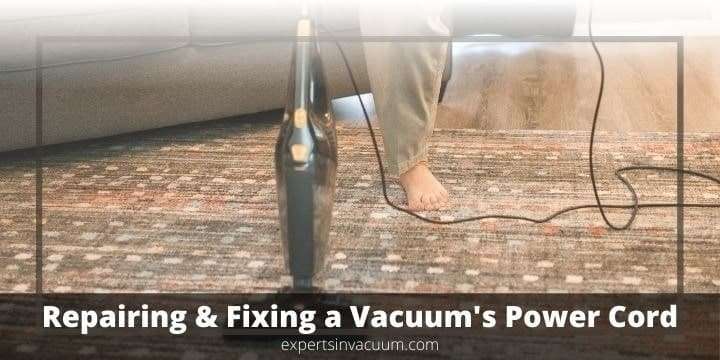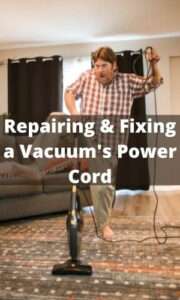A vacuum cleaner power cord is subjected to a great deal of strain, such as when it is wrapped around the vacuum cleaner. The pressure can sometimes cause damage to the power cord, which can have an impact on the vacuum suction and power delivery.
A vacuum cleaner power cord is essential to corded vacuums since they are powered by electricity. When the power cord is damaged, the power supply needed will not be available.

There are a variety of factors that can contribute to the failure of a vacuum cleaner power cord. You can, however, easily repair and replace them without the assistance of a professional.
In this post we will cover:
- What Causes Damage to a Vacuum Cleaner Power Cord?
- How to Repair & Fix Vacuum Cleaner Power Cord: A Step by Step Guide
- How do I replace a vacuum cleaner power cord?
- How do I replace a vacuum cleaner electrical plug?
- How do retractable cords work in a vacuum cleaner?
What Causes Damage to a Vacuum Cleaner Power Cord?
Some of the most common causes that can result in the damage and failure of a vacuum cleaner power cord are provided below:
1. Cord stretching: You may inadvertently overextend the power cord when you are using the machine. That is when the wire is stretched beyond its limit.
The stretching will cause the wires in the power cord to break loose, disrupting electrical current transfer to the vacuum.
2. Twisted cord: Wrapping the power cord around the machine may cause it to twist from one end. The twisting will easily break the wire threads on the inside. When the wire threads break, the vacuum’s motor will fail.
3. Chewed cord: if you are a pet owner, there is a chance that your fur babies may dislike the sound coming from your vacuum or will be afraid of it. In such a case, the pets’ aggression may be taken out on the bitten or chewed cord.
4. Split cord: this is another general damage that may occur on a vacuum cleaner power cord. Some individuals fix the cord by wrapping electrical tape around the area that is damaged.
However, the brush roller located in the vacuum’s bottom is vulnerable to running over the taped cord.
How to Repair & Fix Vacuum Cleaner Power Cord: A Step by Step Guide
1. Inspecting the damaged area: investigate the damaged area of the power cord to access the damage. Thoroughly examine the damaged area to determine whether the defect is at the center, the switch, or the plug.
2. Tape surface damages: if the power cord only has surface damage, tape these areas using electrical tape. The electrical tape is shock sensitive and insulates the thread-like inner wires of the power cord, preventing shocks and sparks.
Avoid the use of masking, duct, or shipping tapes since they do not offer the same protection.
3. Fixing the cord: for you to fix the power cord, you can either cut it and replace the plug with a new one or interweave the wires together. If you choose to interweave the wires, begin by cutting the damaged area of the vacuum cleaner power cord.
Secondly, expose the thin thread-like wire by stripping half an inch of the external plastic part of the cord. Thirdly, twist the wires together, and lastly, use a thick layer of electrical tape to wrap the lines.
4. Replacing the electric plug: cut the power cord two or three inches above the plug and then strip the external plastic wire about half an inch such that each wire is seen clearly.
Uncover the new plug and connect each wire to the corresponding terminals inside the plug. Replace the cover and use the screwdriver to tighten the screws.
5. Additional help: if you cannot repair or fix the power cord of the vacuum cleaner, consult an electric repair professional.
If the vacuum cleaner power cord has been severely damaged, the professional will get rid of the damaged area or replace the entire cord with a new one.
6. Test the vacuum: after successfully repairing the power cord, plug in your machine and check whether it works properly. If the problem persists, there is an issue in another part of the unit.
Additional Suggestions
You can prevent your vacuum cleaner power cord from damage by avoiding these common mistakes:
1. Make sure that the vacuum power cord is kept away from the brushes that roll on the vacuum cleaner’s surface.
2. Avoid wrapping the power cord around the vacuum when you are not using it.
3. Refrain from using the wrong extension cord by always checking the wattage or amp of the machine prior to connecting the extension cord.
4. Inspect the vacuum cleaner power cord as well as other parts of your machine on a monthly basis to prevent shock and sparks that may emanate from the vacuum.
5. While vacuuming the entire house, avoid pulling the power cord.
6. Keep the vacuum cleaner power cord from pets since they may get aggressive and damage the cord.
Conclusion
Generally, vacuum cleaner power cords are prone to damage due to the fact that they are not particularly durable. As a result, if damage occurs, it does not necessitate the purchase of an entirely new vacuum. Simply performing a repair will resolve the situation.
Among the most common causes of damage to a vacuum cleaner power cord include cord stretching, split cords, chewed cords, and twisted cords, to name a few examples. Some damage is simple to repair, while others necessitate some effort.
It is common for all corded vacuums to have a power cord, and repairing a damaged vacuum cleaner power cord is not difficult, and you can do it by yourself. You can follow the steps outlined above and the additional tips to prevent power cord damage.
FAQS
How do I replace a vacuum cleaner power cord?
Begin by removing the old cord and remembering to unplug the vacuum from a power source. Place the vacuum in such a way that the brush roller on the vacuum’s bottom is visible.
Remove the screws that hold the roller in place and pull the brush out after it has been disengaged from its belt.
Remove the screws holding the filter and motor housing in position. Twist the wire nuts that connect the motor and the cord wire counterclockwise.
Separate the wires, and if there is a terminal connection on the white wire, pinch the fastener and pull the connection out of the motor using needle-nose pliers. Pull the wire free by separating the prongs of the terminal with a knife.
Measure the distance between the strain release and the cord’s end. Remove the screws that secure the strain of the cord and cord retainer to the body of the vacuum. Pull the old cord, strain relief, and retainer from the vacuum.
After removing the old cord, attach the new one. Attach the strain relief and cord retainer to the new power cord end. Place it in the same location as the old one. Maintain a similar length of line between the motor and the strain relief. Try not to set them up right now.
Using a sharp blade, remove a half-inch of wire casing and insulation from both the white and black wires. Make an effort not to cut the wires.
Slide the white wires on the string into the terminal once more. Using needle-nose pincers, pleat the terminal shut. Return the terminal to the motor. On the other hand, if the engine associates the white wires with wire nuts, it connects them.
Twist the ends of the colored wires from the cord and motor together, then clockwise twist a wire nut you removed earlier over their ends to secure them together.
Screw the strain relief and cord retainer to the body of the vacuum. Put the new cord in the same spot as the old one.
Reattach the vacuum’s handles. Reattach the motor’s housing. Slide the belt and filter back into place. Place the housing over the brush and tighten the screws.
How do I replace a vacuum cleaner electrical plug?
Electrical plugs are prone to damage as a result of deterioration and incorrect use. However, regardless of the reason for replacement, always choose the same type as the original, so that the wiring of the cord will work. It only takes a few minutes to replace the plug.
Begin by disconnecting the cord wires. Using wire cutters or pliers, cut the electrical cord close to the plug. Remove an inch of the outer insulation to expose the wires. Then, use a utility knife to cut the outer insulation all the way round.
Separate the ends of the wires by pulling them apart. Using a utility knife or strippers on wire pliers, remove half an inch of insulation from the end of each wire. Avoid cutting into the stranded copper wire if you choose to use the knife.
Twist each end of the stranded wires to tighten the strand together by hand.
Attach the new plug after preparing the wire cords. Disassemble the new plug and then connect the ends of the stranded copper wire. Slide the base of the plug onto the power cord’s end with the open end of the prong assembly facing towards the end of the wire.
Wrap the stranded wire ends around the appropriate terminal screws on the inner end of the prong assembly. The black insulated copper wire wraps around the copper screw, while the white insulated copper wire wraps around the silver screw.
A colored screw is wrapped in a green ground wire (green, red, or blue). Tighten all terminal screws tightly against the wires. If the plug has two prongs. Slide its base up the cord and fit it onto the plug assembly’s back.
Grasp the prongs’ sides with one hand and push the fitting’s foundation immovably against the edge of the attachment gathering until it fits properly. Fit the prong insulator over the prongs’ ends and press it into place at the prongs’ foundation.
For a three-prong plug, slide the base with the ground up the cord and align the guide tub with the groove. Push the base into place at the prong assembly’s rim. Securely tighten the screws of the machine at the plug’s flat face.
How do retractable cords work in a vacuum cleaner?
A retractable cord retracts a cord back into a device when it is pulled from the device for a certain distance. That is usually seen in electrical cords that retract back to a device, such as a vacuum cleaner.
The retractable cord of a vacuum cleaner works by providing, excess cords a small storage space. The cord is usually mounted on a set of rotatable wheels that has enough space to accommodate the entire length of the cord.
The cord is usually integrated as a safety feature to prevent it from becoming damaged or being overextended.
When the cord is extended outside the vacuum it reaches its maximum length, you will feel the tension on the cord and you will not be able to move the vacuum any further without moving it closer to the working area.
On some occasions, however, the rewinding cord becomes stuck and refuses to move, creating the possibility of a tripping hazard. You will need to reconnect the spring-loaded retractor that winds the cord around a spool inside the vacuum in order to fix it.

Related Posts